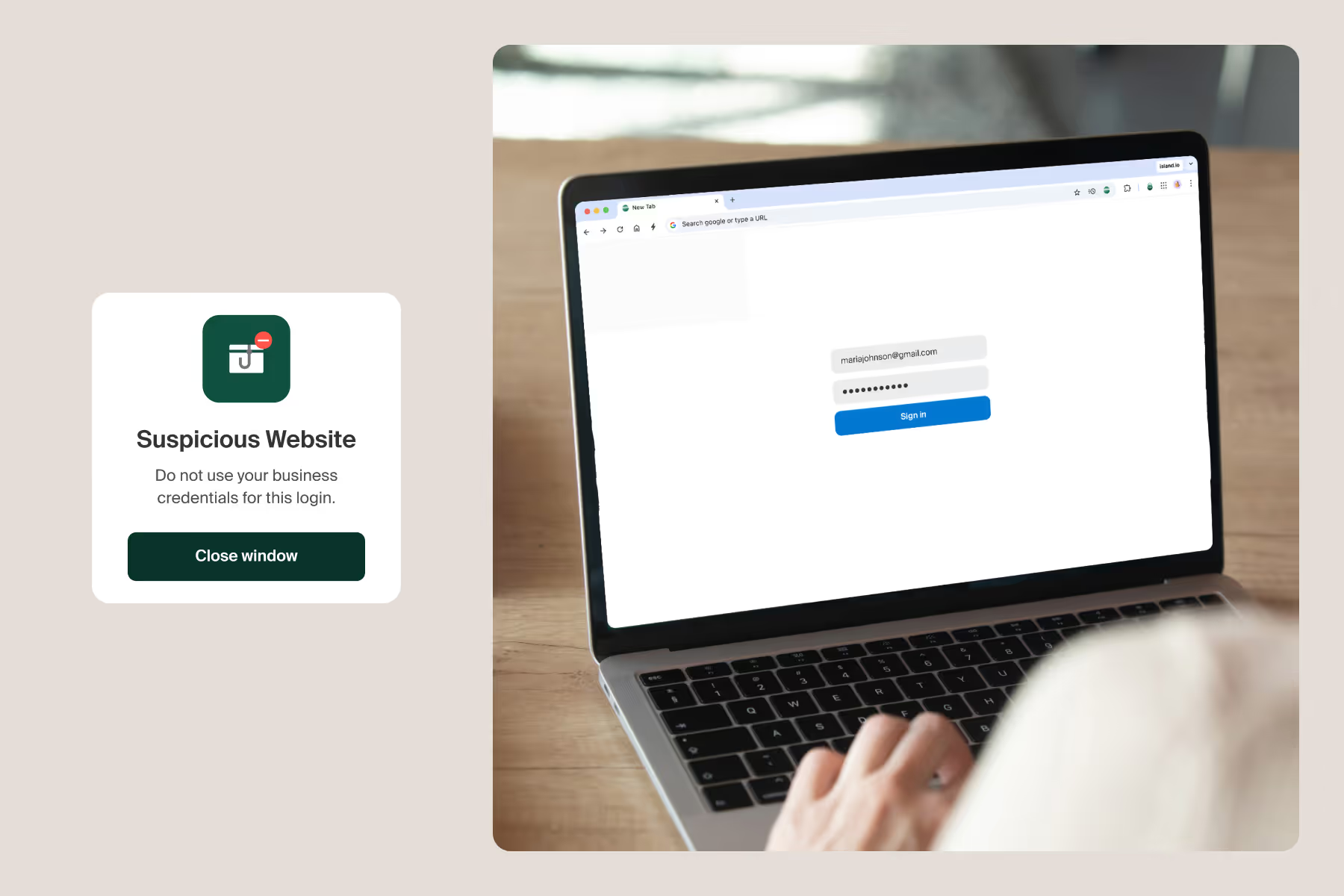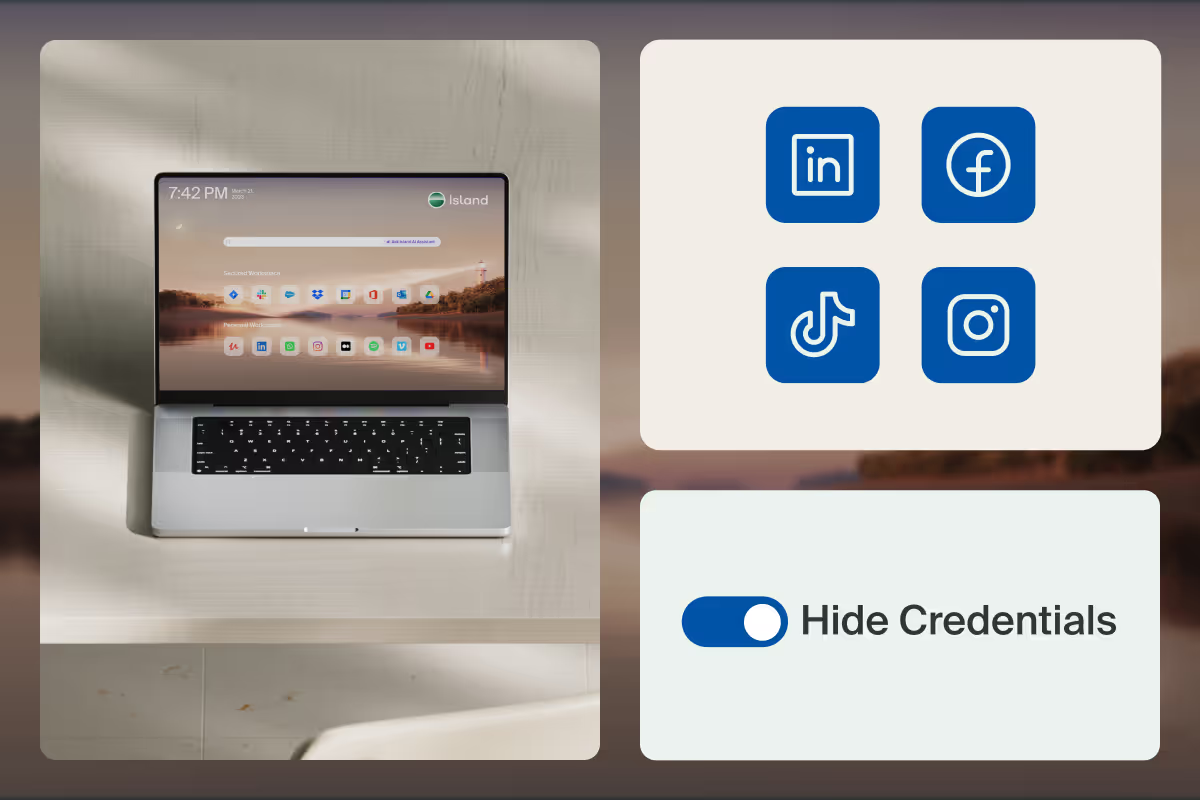How the Enterprise Browser Neutralizes the Risks of Compromised Credentials
Credential theft is surging despite advancements like MFA. Enterprises need protections that traditional browsers can't provide.

Compromised credentials are a hacker’s skeleton key. By stealing usernames, passwords, or authentication tokens, bad actors can slip past defenses unnoticed, gaining access to systems, networks, and sensitive data. The consequences? Identity theft, financial fraud, and massive breaches that leave both individuals and organizations exposed.
And the threat is growing. Researchers recently found that 25% of the malware they collected in 2024 was designed to steal user credentials – a threefold increase from 2023.
Why do compromised credentials present a persistent challenge, despite newer countermeasures such as multi-factor authentication (MFA)? And what role does the browser play in these breaches – as well as in protecting access to the enterprise?
The persistent threat of compromised credentials
Compromised credentials remain a major threat in 2025 due in large part to human behavior. Despite widespread awareness and end-user education initiatives, users continue to reuse passwords or store them insecurely, making them easy targets for attackers. Once stolen, these credentials often end up on the dark web, fueling further breaches.
While enterprises enforce stricter security measures such as MFA, credential theft is far from just a consumer problem. Even with these additional safeguards, major breaches still occur—recent incidents at AT&T, PowerSchool, the U.S. Department of the Treasury, and several other large entities underscore the risk.
Bad actors can gain access despite MFA
How do bad actors pull off compromised credential attacks despite sophisticated security measures like MFA?
Attackers successfully employed a technique known as “MFA fatigue” against Uber. The attacker repeatedly sent MFA push notifications to an Uber employee, hoping to wear them down into approving the request. Eventually, the employee accepted one of these prompts, granting the attacker access to Uber's internal systems. This method exploited the human element of MFA; while MFA adds a layer of security, it can still be vulnerable to social engineering tactics.
Another common attack vector is third-party access. These “supply chain” attacks occur when threat actors target smaller vendors or service providers with weaker security measures to infiltrate their high-value enterprise partners. For example, identity and access management company Okta suffered a breach when attackers gained access to Okta's internal systems through a third-party customer support engineer's account. In supply chain risks, stolen credentials don’t just affect a single organization, but entire ecosystems.
Even in highly regulated industries such as healthcare and government that require physical access cards and tokens for MFA, attackers can gain access to networks through back-end applications or administrative tools where the same access rules aren’t enforced. Patient records are particularly valuable on the dark web—selling for upwards of $60 per record (compared to just $3 for a stolen credit card) due to their wealth of personally identifiable information (PII). In 2024, 67% of healthcare organizations were hit by ransomware, resulting in disruptions in patient care and recovery payouts averaging $2.57 million.
The role of the browser in compromised credential exploitation
A typical consumer browser plays a significant role in the exploitation of compromised credentials because it lacks built-in enterprise security features. Therefore, consumer browsers contribute to credential exploitation in several ways:
- Phishing attacks: Consumer browsers do not inherently prevent users from entering credentials into malicious sites. Attackers use realistic-looking fake login pages to steal usernames and passwords.
- Credential autofill exploits: Many consumer browsers offer to save and autofill credentials, but bad actors can exploit this feature by using malicious scripts to extract stored usernames and passwords.
- Session hijacking and cookie theft: If a user logs into a sensitive application on an unsecured browser, attackers can use techniques like session hijacking or stealing cookies to gain unauthorized access.
- Man-in-the-Browser (MitB) attacks: Malware injected into a consumer browser can manipulate web pages, alter transactions, or steal login credentials before encryption.
- Reused and weak passwords: Consumer browsers do not enforce corporate security policies, leading users to reuse weak passwords across multiple applications, increasing the risk of credential stuffing attacks.
- Malicious extensions: Consumer browsers have no restrictions on third-party extensions, some of which can be malicious or vulnerable, providing attackers a pathway to extract credentials. Even in ‘enterprise-managed’ browser configurations (like Edge or Chrome Enterprise), restrictions in the Chromium API prohibits strict enforcement of certain behaviors of dangerous extensions.
- Lack of granular security controls: Unlike an enterprise browser, a consumer browser does not enforce organization-wide security policies, such as blocking copy-pasting of sensitive data, restricting downloads, or enforcing multi-factor authentication.
How the Enterprise Browser strengthens credential security
Island’s Enterprise Browser mitigates the compromised credential risks inherent in consumer browsers by integrating security directly into the browser, by design. The following Enterprise Browser features play a role in securing the enterprise against these threats:
- Dark web credential monitoring continuously scans for exposed credentials, allowing organizations to enforce password hygiene proactively. If automated scans find corporate credentials on the dark web, the system automatically alerts users and enforces immediate password changes.
- Zero-knowledge privileged access management (PAM) enables employees to access shared credentials without ever seeing the actual password, preventing accidental or malicious leaks. Zero-knowledge PAM and credential management eliminate password exposure when employees leave the company, and they reduce the need for frequent rotations and resets.
This feature is especially valuable in high turnover environments, such as when interns manage an enterprise's social media accounts. It also proves indispensable during mergers and acquisitions, where different teams require different levels of access. For example, executives may require full financial system access, while legal teams access only contracts, and junior employees see no deal-specific information. Rather than sharing passwords or manually enforcing restrictions, the Enterprise Browser dynamically grants role-based access based on identity, device security posture, and location. - Presentation Layer Multi Factor Authentication (MFA) Assertion
While some legacy applications don’t support single sign-on (SSO) options that leverage two-factor authentication, others only assert this validation at initial logon. By leveraging the Enterprise Browser’s unique position at the presentation layer, MFA can be used to require users to authenticate with their identity provider (IdP) credentials along with an MFA challenge to validate the user’s access to privileged applications. It can also assert secondary MFA challenges when users navigate to areas of business applications that represent a higher risk of sensitive data disclosure or information loss. - In-line password transformation dynamically injects credentials into applications, ensuring users never see or handle raw passwords. This feature prevents credential theft, enforces role-based access, and combats phishing, keyloggers, and password reuse.
- Enforced authentication and identity governance ensure that users authenticate through the Enterprise Browser using their existing IdP credentials before accessing critical applications. The browser’s step-up authentication option enforces MFA even when applications don’t natively support or require it. Lastly, browser enforcement prevents users from logging into certain applications from unmanaged consumer browsers.
- Malicious extension detection and prevention block extensions that attempt to steal credentials by logging keystrokes or injecting malicious code. A dynamic risk scoring system continuously evaluates browser extensions, informing administrators’ decisions on which ones to permit and block.
- IP pinning and session protection ensure enterprise resources can only be accessed from approved IP ranges, making stolen credentials useless outside of authorized locations. Whenever suspicious activity is detected, the Enterprise Browser requires authentication re-verification to prevent session hijacking.
- Browser enforcement lets organizations limit access to enterprise data through the Enterprise Browser. With this option, even if attackers have stolen credentials from the dark web and use social engineering to bypass MFA, their attempts to get in on a consumer browser would fail.
- Anti-phishing protection prevents corporate users from registering with non-business sites using their enterprise credentials. These sites might be unauthorized by corporate policy or malicious domains intent on harvesting enterprise user credentials.
- Keylogger protection ensures that passwords entered into a browser form cannot be captured by malicious applications installed on the user device. By filling the keyboard buffer with ‘noise’ within password fields, adversaries have no visibility to the actual keystrokes entered by the user.
Enterprise security with – and without – an Enterprise Browser
Let’s explore a comparison between two fictional enterprises: one with the Enterprise Browser, and one without.
Enterprise A, which relies on an unmanaged consumer browser, faces significant security risks. Employees’ credentials can be exposed on the dark web without detection, leaving them vulnerable to unauthorized access. Shared accounts require constant password resets whenever employees leave, creating operational friction. If attackers manage to bypass MFA, they can log in from any device without restriction. Additionally, risky browser extensions can operate undetected, potentially siphoning off login credentials and compromising sensitive data.
In contrast, Enterprise B, which uses the Island Enterprise Browser, benefits from built-in security measures that mitigate these risks. Continuous monitoring detects compromised credentials. Zero-knowledge access protects shared logins, so employees never see the actual passwords. Login enforcement restricts access to secure, controlled environments, preventing unauthorized logins from unmanaged devices. Malicious extensions are proactively detected and blocked before they can harvest credentials, ensuring a safer browsing experience.
The Enterprise Browser: A highly secure, granularly controlled authentication environment
As credential-based threats continue to rise, organizations can no longer depend solely on usernames, passwords, or even traditional MFA to protect sensitive data. Attackers always find new ways to bypass authentication measures, making it critical to secure credentials at their core.
The Enterprise Browser establishes a highly controlled, secure authentication environment that can prevent credential theft and exploitation before it can happen. By embedding advanced security controls directly into the browser, it ensures that even if credentials are compromised, they cannot be misused.
For IT and security teams, this means true peace of mind from continuous protection of user access, granular authentication enforcement, and minimal risk of credential-based attacks. With the Enterprise Browser, organizations can finally stay ahead of attackers—not just reacting to threats, but eliminating them from the start.
.svg)








.svg)
.svg)
